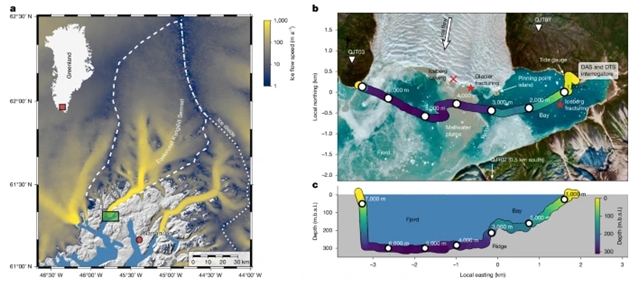
近日,美国华盛顿大学Dominik Gräff团队实现了海底光纤传感解决由崩裂驱动的峡湾动力学问题。相关论文于2025年8月13日发表在《自然》杂志上。
融化的冰和变暖的海洋之间的相互作用导致了今天格陵兰岛潮汐冰川的退缩,这对海平面上升和全球气候系统都有影响。在控制冰川锋面消融的过程中,这些冰与海洋的相互作用涉及一系列小规模过程,这些过程将冰川崩解(冰山的分离)和海底融化与更广泛的峡湾动态联系起来。然而,人们对这些过程的了解仍然有限,这在很大程度上是由于在锋面附近的危险环境中进行有针对性的观测具有足够的时间和空间分辨率所带来的挑战。
通过对瞬态内波的激发,冰山崩解可以起到海底融化放大器的作用。研究组的观察基于对冰山崩解过程链的前端-近端海底光纤传感。在这个链条中,冰裂开始于持续的冰裂,并合并成冰山分离,这反过来又激发了局部海啸、内部重力波和冰锋的短暂洋流,然后冰山最终衰变成碎片。该观察显示了以前未知的途径,其中潮汐冰川与变暖的海洋相互作用,并帮助关闭冰锋消融预算,这是目前的模型难以做到的。这些见解提供了与全球退潮冰川相关的新的过程尺度的理解。
附:英文原文
Title: Calving-driven fjord dynamics resolved by seafloor fibre sensing
Author: Grff, Dominik, Lipovsky, Bradley Paul, Vieli, Andreas, Dachauer, Armin, Jackson, Rebecca, Farinotti, Daniel, Schmale, Julia, Ampuero, Jean-Paul, Berg, Eric, Dannowski, Anke, Kneib-Walter, Andrea, Kpfli, Manuela, Kopp, Heidrun, van der Loo, Enrico, Mata Flores, Daniel, Mercerat, Diego, Moser, Raphael, Sladen, Anthony, Walter, Fabian, Wasser, Diego, Welty, Ethan, Wetter, Selina, Williams, Ethan F.
Issue&Volume: 2025-08-13
Abstract: Interactions between melting ice and a warming ocean drive the present-day retreat of tidewater glaciers of Greenland1,2,3, with consequences for both sea level rise4 and the global climate system5. Controlling glacier frontal ablation, these ice–ocean interactions involve chains of small-scale processes that link glacier calving—the detachment of icebergs6—and submarine melt to the broader fjord dynamics7,8. However, understanding these processes remains limited, in large part due to the challenge of making targeted observations in hazardous environments near calving fronts with sufficient temporal and spatial resolution9. Here we show that iceberg calving can act as a submarine melt amplifier through excitation of transient internal waves. Our observations are based on front-proximal submarine fibre sensing of the iceberg calving process chain. In this chain, calving initiates with persistent ice fracturing that coalesces into iceberg detachment, which in turn excites local tsunamis, internal gravity waves and transient currents at the ice front before the icebergs eventually decay into fragments. Our observations show previously unknown pathways in which tidewater glaciers interact with a warming ocean and help close the ice front ablation budget, which current models struggle to do10. These insights provide new process-scale understanding pertinent to retreating tidewater glaciers around the globe.
DOI: 10.1038/s41586-025-09347-7
Source: https://www.nature.com/articles/s41586-025-09347-7
Nature:《自然》,创刊于1869年。隶属于施普林格·自然出版集团,最新IF:69.504
官方网址:http://www.nature.com/
投稿链接:http://www.nature.com/authors/submit_manuscript.html
